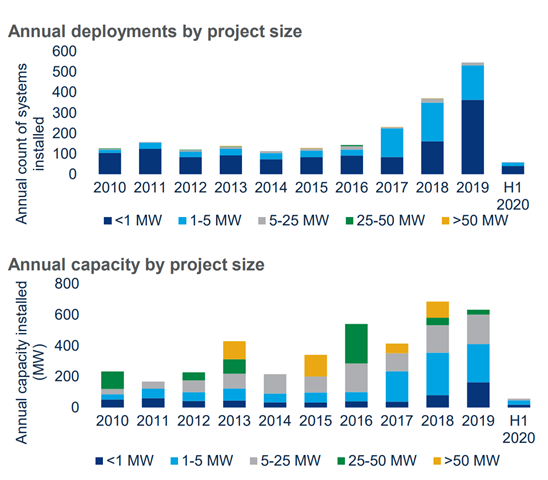Microgrid finance 2020: The emergence of the 'Energy as a Service' business model
1 minute read
Complete the form to receive the full complimentary report
In news articles, press releases, and industry presentations, 'Energy as a Service' is highlighted as a new business model driving microgrid deployment in the United States. Examples include leading developers and suppliers including Schneider Electric, Enchanted Rock, Siemens and others. In this study, we set out to determine the accuracy of these claims, clarify the different business models behind microgrid deployment and explore the landscape for financiers.
The microgrid market was consistent from 2010-2016
From 2010 to 2016, the microgrid market had been relatively stable: between 100 and 160 microgrids were installed each year. Annual capacity installed was driven by the completion of relative few projects above 5 MW. During this period, microgrid developers often said, “If you’ve seen one microgrid, you’ve seen one microgrid” to emphasize the customization of each project. That changed beginning in 2017. Projects below 5 MW started consistently growing both in cumulative annual capacity and number of systems installed. Standardization of DERs and cost declines of those resources enabled those projects:
- Standardization of energy resources: Smaller systems have been standardized around individual DERs that are built in a factory. This decreases capital expense cost for smaller systems because each system does not need to be custom built. Much of the savings comes from decreased construction time and associated costs.
- Declining cost of energy resources: Also, individual DERs have decreased in cost. From 2014 to H1 2020, cost declined 36% for commercial solar systems and 25% for behind-the-meter energy storage. In addition, innovation led to cost declines for fuel cells from Bloom Energy, Enchanted Rock’s natural gas microgrid, and PowerSecure’s tier 4 diesel PowerBlock system.
Projects below 5 MW started taking off because of standardization and cost declines in 2017
Source: Wood Mackenzie Grid Edge Service
To continue reading and receive our full complimentary report 'Microgrid finance 2020: The emergence of the 'Energy as a Service' business model' please fill out the form.






